The Life-Giving I AMs of Jesus: The True Vine
“I AM the true vine, and My Father is the vinedresser.” (John 15:1)

Lauren Crews
This is the eighth, and next-to-final, post in a series on The Life-Giving I AMs of Jesus. I’ve been honored to develop this series in partnership with Lauren Crews, a soon-to-be-published author and a regular guest here at Five Stones and a Sling. You’ll find the links to earlier posts in the series at the bottom of this one.
As we near the end of our series on the “I AMs of Yeshua,” we’re also nearing the end of His earthly ministry. His first public I AM statement, “I AM the bread of life,” took place as Passover was approaching (John 6:4), and now we’ve progressed through a full year to Passover again.
For this week’s “I AM” statement, our curtain rises as Yeshua celebrates His Last Supper with His disciples at a Passover seder feast. The I AM statements we’ve looked at to date have established Him, not only as Messiah, but also as God incarnate. But He knows well that what’s coming is going to shake these men to the core and bring everything He’s urged them to believe about Him into question. So at this meal, He gives them a double dose of “I AM” to cling to.
We’ll focus on the second of these I AM statements today, and come back to the first one in the next post.
Timing Is Everything
The chapter break in our Bibles obscures the context a bit. Yeshua’s “true vine” statement comes at a poignant moment, as He wraps up their meal with some explicit foreshadowing:
Peace I leave with you; My peace I give to you; not as the world gives do I give to you. Do not let your heart be troubled, nor let it be fearful. You heard that I said to you, ‘I go away, and I will come to you.’ If you loved Me, you would have rejoiced because I go to the Father, for the Father is greater than I. Now I have told you before it happens, so that when it happens, you may believe. I will not speak much more with you, for the ruler of the world is coming, and he has nothing in Me; but so that the world may know that I love the Father, I do exactly as the Father commanded Me. Get up, let us go from here. (John 14:27-31)
The “let us go from here” marks the moment that they get up to leave the Upper Room and set their feet on the path to Gethsemane.
Continuing into Chapter 15:
I am the true vine, and My Father is the vinedresser. Every branch in Me that does not bear fruit, He takes away; and every branch that bears fruit, He prunes it so that it may bear more fruit…. Abide in Me, and I in you. As the branch cannot bear fruit of itself unless it abides in the vine, so neither can you unless you abide in Me. I am the vine, you are the branches; he who abides in Me and I in him, he bears much fruit, for apart from Me you can do nothing. (John 15:1-5)
Lauren:
Yeshua is transitioning His disciples to the New Covenant, in which:
“He who has My commandments and keeps them is the one who loves Me.” (John 14:21)
These words echo Deuteronomy 28. As the Israelites were about to enter the Promised Land to plant themselves in the unknown, God outlined what was necessary for them to experience His favor and be fruitful. He also warned of His curses if they did not follow His commands.
Here at the Last Supper, Yeshua establishes the New Covenant–and outlines the means by which His followers will experience God’s favor and be fruitful in it.
“I AM the true vine.” (John 15:1)
“I am the vine, you are the branches; he who abides in Me and I in him, he bears much fruit.” (John 15:5)
Linda:
Not an elaborate list of do’s and don’ts. Just an admonition to abide. That’s a tectonic shift!
Photo by Nacho Domínguez Argenta on Unsplash
Manzaneres, Spain
Lauren:
Exactly. Abide, or its synonym remain, is used forty times in the book of John. It is the Greek word meno. It means to continue, to dwell, to remain until the end. As He said earlier that evening:
I will ask the Father, and He will give you another Helper, that He may be with you forever; that is the Spirit of truth, whom the world cannot receive, because it does not see Him or know Him, but you know Him because He abides with you and will be in you. (John 14:16-17)
Yeshua was leaving their physical presence to be replaced by the Helper, the Spirit of God, who would abide in them just as Yeshua and the Father abide together.
In me is another repeated phrase, used several times already that evening. Yeshua clarifies the transition and confirms that, no matter what things may look like, they will be able to remain in Him.
- Yeshua is in the Father and the Father in Him (John 14:10).
- Yeshua does not speak on His own initiative, but the Father abiding in Him does His works (John 14:11).
- Believers will know the Helper, the Spirit of truth, because He abides with them and will be in them (John 14:17).
- In that day believers will know that Yeshua is in My Father, and they will be in Yeshua and He in them (John 14:20).
Why would Yeshua choose a vine as the image of this new paradigm? In an agrarian setting, His audience would recognize the parallels, but what are we missing?
Here’s an early excerpt from my upcoming book, The Strength of a Woman, releasing from New Hope Publishers in October.
When planting vineyards, where you plant and the type of soil in which you plant is just as important as the type of grape you plant. The soil, the slope of the land, the field preparation all work together to determine the fruit’s production. Dry soil regions produce small grapes that are rich in flavor. Wet soil regions, with an excess of rain, will produce large, plump grapes but the flavor of the grape may be more diluted. Growers hope for wet soil as the new vines are beginning to bud and grow because the wet soil will encourage tight, flavorful clusters. But, rain prior to harvest is dreaded because it can plump the grape too much, thereby diluting the flavor and ruin the crop.
Each year, the vinedresser must decide if he should keep the ancient vines which produce the better quality grape, plant new vines, or graph new shoots into the old root system. The ancient vines can live and produce more than one hundred years. Well into the next generation and beyond.
The vinedresser must continuously inspect the fruit to see if mold or decay is forming inside the cluster of grapes.
As I now abide with the Spirit of God in this land of in between, just as the disciples did, several questions come to mind.
- In what type of soil have I planted myself? Has my faith and actions settled and become comfortable, plump and diluted? Do I need to take a soil sample?
- What type of fruit am I producing? It is moldy or in decay?
- Do I require pruning? What needs to be cut away?
- Am I hindering other branches from producing?
- What passions are consuming me?
- Do I actively remain in Christ? His Spirit abides in me. It doesn’t come and go. Does my life acknowledge that truth?
Photo by Jose Ramon Gil on Unsplash
Cariñena, Spain
Is a False Vine a Thing?
Linda:
Those are telling questions, Lauren. And the background on vine growing is very illuminating. I’m so excited for your new book!
And speaking of telling questions, here’s another one. We’ve talked about the word “vine.” But why does Yeshua emphasize the word “true”? Why is He the “true vine”? Is a “false vine” a thing?
As I ponder this in my own life, I see oh-so-clearly that it is–and it’s a vivid picture.
Yeshua is talking here about what sustains us as we grow and bear fruit. What sustains (energizes) me? The approbation of others? Some vision of success or position? Human wisdom? Worldly values? Maybe even a pastor or teacher? To whatever degree I’m relying on anything that isn’t Christ, I’m attempting to leech nourishment from a false vine.
Photo by Kaylee Garrett on Unsplash
Oakdale, California, U.S.A.
And I’ve started calling myself on it–“That’s my false vine talking!” (I found this teaching on The Upside Down Kingdom by Timothy Keller to be very radical in flagging many areas where I’m drawing sustenance from the wrong vine.)
False Leaders and the False Vine
What Lauren and I have been trying to do in this series is crawl into the head of a first-century Jewish person listening to Messiah. And here again, Yeshua’s words would have brought some context from the Hebrew scriptures to the disciples’ minds. Israel–God’s chosen people–is pictured often in scripture as His vine, which has become corrupted and needs restoration (Jer 2:21, Ez 17:5-6, Hosea 10:1, Ps 80:8-19).
“Yet I planted you a choice vine,
A completely faithful seed.
How then have you turned yourself before Me
Into the degenerate shoots of a foreign vine?” (Jer 2:21)
So as the true vine, Yeshua has come to restore God’s people to the wholesome fruitfulness they were meant to enjoy. And He echoes many of His previous I AM statements in confronting the corruption of the nation’s current leaders, who have allowed God’s vineyard to be trampled (Jer 12:10-11) and His vine to degenerate.
Yes, He is “all that”… The True Vine, the Good Shepherd, the Light, the Door… Everything Israel’s religious leaders pretend to be, but are not.
To Gethsemane–And Calvary
It’s also worth noting that the fruit of the vine is already a highly loaded image. Yeshua used it twice, earlier that same evening.
And when He had taken a cup and given thanks, He said, “Take this and share it among yourselves; for I say to you, I will not drink of the fruit of the vine from now on until the kingdom of God comes.”… And in the same way He took the cup after they had eaten, saying, “This cup which is poured out for you is the new covenant in My blood.” (Luke 22:17-18,20)
So Yeshua used the fruit of the vine to foreshadow the bitterness of separation, the joy of an eventual reunion when the Kingdom of God comes, and to give a vivid picture of how He will sacrificially give up His life to accomplish that.
And as Yeshua and His disciples rise from the table and set their sandals on the path to Gethsemane…
Ancient olives in the Garden of Gethsemane
I see one more implication of the vine analogy to explore.
Fruit is a common motif throughout the Bible, and several events on the Mosaic calendar revolve around celebrating the fruitfulness of the land. The first of these, due in just a few days, is the Feast of Firstfruits. And just as Messiah’s death at Passover will have profound significance, His resurrection on the Feast of Firstfruits, during the Feast of Unleavened Bread, will speak volumes.
Now on the first day of the week, very early in the morning, they… came to the tomb… (Luke 24:1)
The day of Yeshua’s resurrection wouldn’t be just any first day of the week. This first day–the day after the Shabbat following Passover–would be the Feast of Firstfruits.
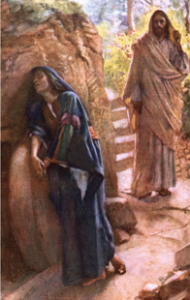
Harold Copping, Mary Magdalene at the Sepulchre
On the Feast of Firstfruits, the first-begotten of the Father (Heb 1:6)
and the Firstborn of Creation (Col 1:15-16)
became the Firstfruits of those who
will be resurrected (1 Cor 15:20-23).
Firstfruits: An Ancient Type of the Resurrection
The Feast of Firstfruits was a special presentation of the “first of the firstfruits”–the barley–(Ex 34:26) to God. Here’s what would happen:
The priest was to wave the sheaf before [the Lord], i.e., to present it symbolically to [the Lord] by the ceremony of waving, without burning any of it upon the altar. The rabbinical rule… to dry a portion… and then… to burn them on the altar, was an ordinance of the later scribes.
– Keil and Delitzsch Biblical Commentary on the Old Testament
This wave offering of the first fruits was another picture of Messiah! Our Lord’s offering was pure and undefiled. Nothing needed to be consumed on the altar before He could ascend to the Father.
… A male lamb was then sacrificed as a burnt offering to the Lord along with a minchah (unleavened bread mixed with oil) and wine (Lev 23:13). Only after the wave offering was performed could the crop begin to be used (Lev 23:14).
It is altogether remarkable that on this day a defect-free male lamb was to be offered along with bread and wine–the very symbols Yeshua used to recall his sacrifice…
– John J. Parsons, Hebrew4Christians.com
The “first first fruits” of the barley harvest presented at this Feast were a foretaste of a succession of first fruits celebrations that continued throughout the summer. Seven weeks later, the first fruits of the wheat harvest were presented in a wave offering (in this case, of baked loaves) at the fourth Feast of the Lord, Shavuot / Pentecost, which would also be a key milestone in the birth of the New Covenant.
And throughout the growing season, farmers from the villages would stream into Jerusalem, bringing their first fruits of grain and fruit (fresh or dried), and even wool from their sheep, to the Temple as per Deut 18:4.
The mitzvah of bikkurim (first fruits) began when a farmer… would go out to his field and find budding fruit, and tie a reed around them, verbally declaring them “first fruits.”… Wealthy people would use trays of gold and silver, and simple folk would use baskets of grass and reeds…. Villagers of each region would gather [periodically] in a central town…. An ox with horns coated in gold would lead the procession, a crown of olive branches on its head…. A flute was played before the procession until it approached Jerusalem…. All of the artisans in Jerusalem would stand and greet them: “Our brethren, the inhabitants of so-and-so, you have come in peace.”
…a festive acknowledgment of the connection between God and the bounty of the land and His blessing on the entire economy. Again, a powerful analogy to what Yeshua tells the disciples will sustain their fruitfulness is this new-covenant economy–abiding in Him.
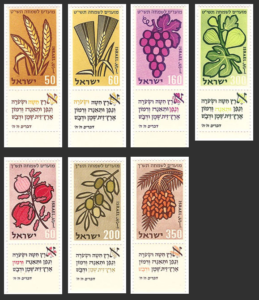 The seven species of ancient Israel.
The seven species of ancient Israel.
Barley, wheat, grapes, figs,
pomegranates, olives, dates–all
would be presented as “first fruits.”
(Stamps from 1958)
Like the “first of the firstfruits,” our Lord’s resurrection is a foretaste of a much greater harvest that will come in.
But now Christ is risen from the dead, and has become the firstfruits of those who have fallen asleep…. But each in his own order: Christ the first fruits, after that those who are Christ’s at His coming. (1 Cor 15:20-23)
…that He might be the firstborn of many brethren… (Rom 8:29)
Did You Know You Are Also “Firstfruits”?
Of His own will He brought us forth by the word of truth, that we might be a kind of firstfruits of His creatures. (James 1:18)
But each one in his own order: Christ the firstfruits, afterward those who are Christ’s at His coming. Then comes the end, when He delivers the kingdom to God the Father, when He puts an end to all rule and all authority and power. (1 Cor 15:23-24)
We who have chosen to accept Yeshua’s reign in our lives are the “firstfruits” of the entire creation–which will accept His reign, willingly or not, on the day when every knee bows and every tongue confesses that Jesus Christ is Lord (Phil 2:10-11).
The wise will run to Yeshua for salvation NOW. While they can still be marked and brought in as a “firstfruit offering,” rather than waiting to be threshed or crushed during the harvest that will come!
Photo by Bianca Isofache on Unsplash
If you’ve never opened God’s free gift of salvation through Jesus (Rom 3:23, 6:23), please please please be persuaded to do it now! It’s simple. Just tell God from your heart that you admit you’re a sinner that needs a Savior (“For all have sinned and fall short of the glory of God.” Rom 3:23) that you’re done running your own life, and that you’re ready to make Jesus Lord of your life.
If you confess with your mouth Jesus as Lord, and believe in your heart that God has raised Him from the dead, you shall be saved. For with the heart a person believes, resulting in righteousness, and with the mouth he confesses, resulting in salvation. For the Scripture says, “Whoever believes in Him will not be disappointed.” (Rom 10:9-11)
The decision that saves you is that simple!
Simple… But no one said living it out will be easy. Especially now.
Here are the previous posts in the series:
- I AM the Bread of Life
- I AM the Light of the World
- I AM the Door
- I AM the Good Shepherd (Part 1)
- I AM the Good Shepherd (Part 2)
- Light of the World (Selah)
- I AM the Resurrection and the Life
As a Bible teacher and speaker, Lauren Crews is excited to encourage Christians to explore and understand the Jewish roots of their faith. She lives in northeast Florida with her husband and two chocolate labs. She is mom of three fantastic young adults and recently welcomed a daughter-in-love to the Crews crew. She is represented by Credo Communications and working toward the publication of her books The Strength of a Woman and Jesus: The Alef and the Tav. You can connect with Lauren on the web at www.laurencrews.com.
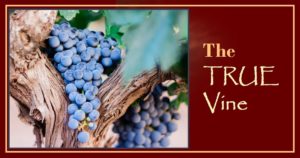
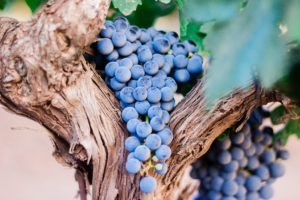
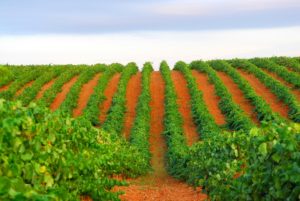
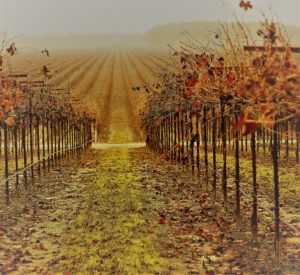

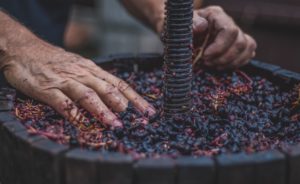
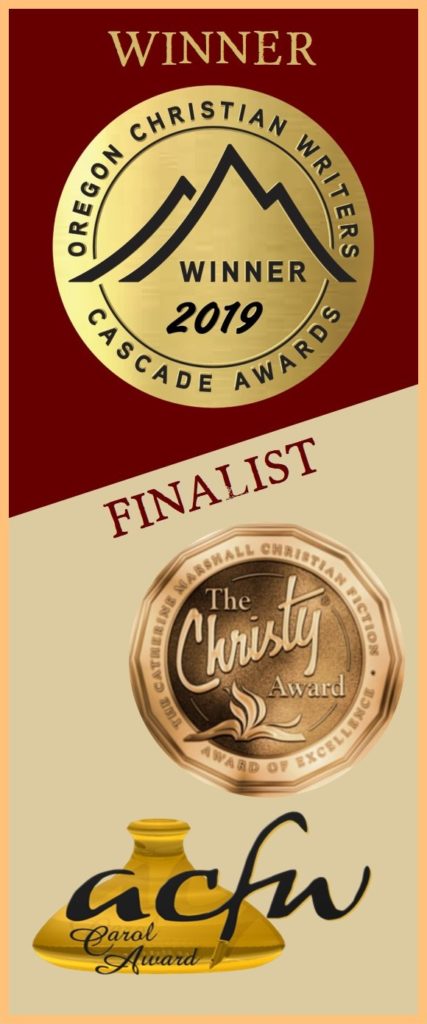
No Comments